当前位置:
X-MOL 学术
›
Macromolecules
›
论文详情
Our official English website, www.x-mol.net, welcomes your
feedback! (Note: you will need to create a separate account there.)
Achieving Uniform Lithium Electrodeposition in Cross-Linked Poly(ethylene oxide) Networks: “Soft” Polymers Prevent Metal Dendrite Proliferation
Macromolecules ( IF 5.1 ) Pub Date : 2020-06-30 , DOI: 10.1021/acs.macromol.0c00475 Sanjuna Stalin 1 , Hillis E. N. Johnson 2 , Prayag Biswal 1 , Duylinh Vu 1 , Qing Zhao 1 , Jiefu Yin 1 , Brooks A. Abel 2 , Yue Deng 3 , Geoffrey W. Coates 2 , Lynden A. Archer 1
Macromolecules ( IF 5.1 ) Pub Date : 2020-06-30 , DOI: 10.1021/acs.macromol.0c00475 Sanjuna Stalin 1 , Hillis E. N. Johnson 2 , Prayag Biswal 1 , Duylinh Vu 1 , Qing Zhao 1 , Jiefu Yin 1 , Brooks A. Abel 2 , Yue Deng 3 , Geoffrey W. Coates 2 , Lynden A. Archer 1
Affiliation

|
The propensity of lithium to form nonplanar, mossy, or dendritic electrodeposits at current densities below the diffusion limit is a well-known, fundamental barrier to commercialization of energy-dense storage in lithium metal batteries. It has been proposed that proliferation of Li dendrites can be eliminated by controlling the uniformity and size of the deposits to levels where surface tension and other small-scale interfacial forces are able to planarize the deposition. Herein, we investigate lithium electrodeposition in uniformly porous, nanostructured media formed in cross-linked poly(ethylene oxide) polymer networks enabled by thiol–ene click chemistry. Using galvanostatic strip-plate experiments along with scanning electron microscopy and operando visualization techniques, we critically assess the effectiveness of these materials in enabling uniform, planar deposition of lithium. We report that thiol–ene click networks that host a liquid electrolyte in their pores are more effective than their liquid electrolyte or solid polymer network components in regulating Li deposition at both the nucleation and growth phases. It is shown further that compressive interfacial stresses imparted by the networks during electrodeposition may serve to augment surface tension to enable uniform Li electrodeposition. The practical relevance of these electrolytes is demonstrated in full-cell battery configurations with excellent long-term stability.
中文翻译:

在交联聚环氧乙烷网络中实现均匀的锂电沉积:“软”聚合物可防止金属枝晶扩散
锂在低于扩散极限的电流密度下形成非平面,生苔或树枝状电沉积的倾向是锂金属电池中能量密集型存储商业化的众所周知的基本障碍。已经提出,可以通过将沉积物的均匀性和尺寸控制在表面张力和其他小规模界面力能够使沉积物平坦化的水平来消除Li树枝状晶体的扩散。在本文中,我们研究了在硫醇-烯点击化学作用形成的交联聚环氧乙烷聚合物网络中形成的均匀多孔的纳米结构介质中的锂电沉积。使用恒电流带状板实验以及扫描电子显微镜和手术可视化技术,我们严格评估这些材料在使锂均匀,平面沉积方面的有效性。我们报告说,在其孔隙中含有液态电解质的硫醇-烯点击网络比其液态电解质或固体聚合物网络组件在调节成核和生长阶段的Li沉积方面更有效。进一步显示,在电沉积期间由网络施加的压缩界面应力可用于增加表面张力以实现均匀的锂电沉积。这些电解质的实用意义在具有出色长期稳定性的全电池配置中得到了证明。我们报告说,在其孔隙中含有液态电解质的硫醇-烯点击网络比其液态电解质或固体聚合物网络组件在调节成核和生长阶段的Li沉积方面更有效。进一步显示,在电沉积期间由网络施加的压缩界面应力可用于增加表面张力以实现均匀的锂电沉积。这些电解质的实用意义在具有出色长期稳定性的全电池配置中得到了证明。我们报告说,在其孔隙中含有液态电解质的硫醇-烯点击网络比其液态电解质或固体聚合物网络组件在调节成核和生长阶段的Li沉积方面更有效。进一步显示,在电沉积期间由网络施加的压缩界面应力可用于增加表面张力以实现均匀的锂电沉积。这些电解质的实用意义在具有出色长期稳定性的全电池配置中得到了证明。
更新日期:2020-07-14
中文翻译:

在交联聚环氧乙烷网络中实现均匀的锂电沉积:“软”聚合物可防止金属枝晶扩散
锂在低于扩散极限的电流密度下形成非平面,生苔或树枝状电沉积的倾向是锂金属电池中能量密集型存储商业化的众所周知的基本障碍。已经提出,可以通过将沉积物的均匀性和尺寸控制在表面张力和其他小规模界面力能够使沉积物平坦化的水平来消除Li树枝状晶体的扩散。在本文中,我们研究了在硫醇-烯点击化学作用形成的交联聚环氧乙烷聚合物网络中形成的均匀多孔的纳米结构介质中的锂电沉积。使用恒电流带状板实验以及扫描电子显微镜和手术可视化技术,我们严格评估这些材料在使锂均匀,平面沉积方面的有效性。我们报告说,在其孔隙中含有液态电解质的硫醇-烯点击网络比其液态电解质或固体聚合物网络组件在调节成核和生长阶段的Li沉积方面更有效。进一步显示,在电沉积期间由网络施加的压缩界面应力可用于增加表面张力以实现均匀的锂电沉积。这些电解质的实用意义在具有出色长期稳定性的全电池配置中得到了证明。我们报告说,在其孔隙中含有液态电解质的硫醇-烯点击网络比其液态电解质或固体聚合物网络组件在调节成核和生长阶段的Li沉积方面更有效。进一步显示,在电沉积期间由网络施加的压缩界面应力可用于增加表面张力以实现均匀的锂电沉积。这些电解质的实用意义在具有出色长期稳定性的全电池配置中得到了证明。我们报告说,在其孔隙中含有液态电解质的硫醇-烯点击网络比其液态电解质或固体聚合物网络组件在调节成核和生长阶段的Li沉积方面更有效。进一步显示,在电沉积期间由网络施加的压缩界面应力可用于增加表面张力以实现均匀的锂电沉积。这些电解质的实用意义在具有出色长期稳定性的全电池配置中得到了证明。











































 京公网安备 11010802027423号
京公网安备 11010802027423号